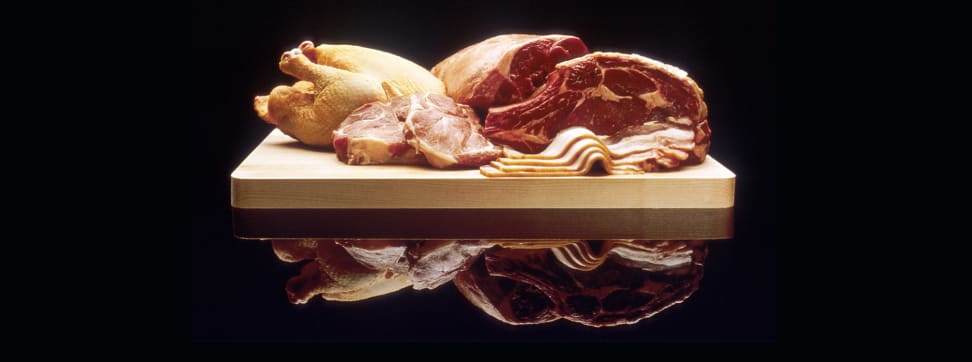Everything You Need to Know to Defrost Meat
Because it’s more complicated than you think. Sort of.
 Credit:
Credit:
Products are chosen independently by our editors. Purchases made through our links may earn us a commission.
Believe it or not, there are only two ways to thaw frozen food: patiently and impatiently. As with most things in life, a job done quick isn't necessarily a job done well.
The two most important factors in thawing frozen food, particularly meat, are time and temperature. How long a given food item needs to defrost is directly proportional to the temperature at which it thaws. And that means there are really only three options available to you, depending on your patience. Here they are, ranked in order of most ideal to least.
Use your fridge
Defrosting meat in your fridge takes longest, but works best. Depending on the size of the cut in question, it may take up to 24 hours to fully thaw a frozen piece of meat. A general rule is that you should set aside one day of defrost time for every five pounds of meat.
While all that time and preparation may not sound ideal, it is certainly the safest method. Remember that many species of bacteria, including E. coli and salmonella, are not killed by freezing temperatures—they just become dormant and grow more slowly. Once you take meat out of the freezer and set it on the counter, those bacteria start growing again. Plus, your meat may be exposed to other germs that increase the risk of contamination.
RELATED: In the Kitchen with the King of Memphis Barbecue [Video]
Fridge temperatures (roughly 40°F or less) slow the rate of contamination, which is inevitable. Unless you’re defrosting a large bird, you shouldn’t require more than a day or two for defrosting. If your fridge is set at a lower temperature than normal, raise it to 40°F for the duration of the defrost. As a general rule, ground meats shouldn’t stay in the fridge more than two days. Steaks and chops can remain for up to four or five days, and cooked meat or seafood should be tossed after four days.
Cold Water
Submerging a sealed piece of meat in a bowl of cold water is probably the most popular way to quickly defrost frozen meat. It still takes a decent amount of time, but doesn’t usually require a whole day’s preparation. One pound of frozen meat usually requires about one hour to fully thaw using this method—add another 30 minutes per additional pound. You should cook the meat directly after thawing.
There is some debate over whether or not you should thaw food—especially meat—in a bowl of hot or warm water. The general consensus is that this is fine for small cuts—like steaks and chicken strips—so long as you keep the meat sealed in a waterproof and airtight bag. The risk has to do with how long meat is exposed to the “danger zone” of microbial growth, which is roughly between 40°F to 135°F. With long cuts of meat—such as roasts, briskets, and pork shoulders—the exterior of the meat suffers prolonged exposure to these temperatures, and may become contaminated.
The other problem with thawing meat in hot water is that it actually begins to cook the outside of the meat, forcing it to undergo the Maillard Reaction. This will dry out the meat and lead to an uneven cook. Best stick to cold water thawing.
Microwave
This is certainly the quickest way to defrost meat. But we’re not convinced it’s the ideal method, if only for culinary reasons. For one, there is the risk of overcooking the meat. Even if thawed on a microwave’s defrost cycle, the meat can be excessively heated in certain spots, causing variations in the “evenness” of the cook.
Think about how a microwave works: Microwave radiation is scattered throughout the interior of the machine, forcing certain molecules—particularly water and fats—to go into rapid motion and disperse heat energy. Because the heat depends on the presence of excitable molecules, certain areas of the food may become more cooked than others.
To be clear, microwaves are a safe way to defrost food, at least with regards to microbial contamination (there's some debate over what microwaves do to nutrients). But a decrease in the quality of the food is almost certainly going to result in a damp, rubbery texture. There’s a reason top restaurants don’t employ an army of microwaves to defrost their food. It just doesn’t taste good.
